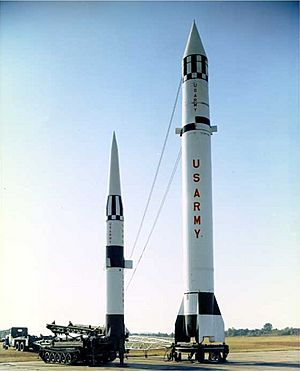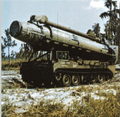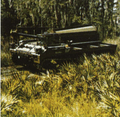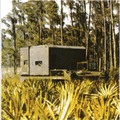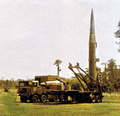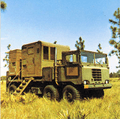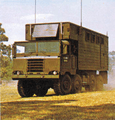MGM-31 Pershing facts for kids
The MGM-31A Pershing was a powerful missile used by the United States Army and the German Air Force. It was a solid-fueled missile with two stages, meaning it had two parts that burned fuel to make it fly. This ballistic missile was built by Martin Marietta.
The Pershing missile was made to replace older missiles like the PGM-11 Redstone and MGM-1 Matador. It was a key nuclear weapon for the U.S. Army. Later, it also replaced the MGM-13 Mace cruise missiles.
Work on the Pershing started in 1958. The first test missile flew in 1960. The Pershing 1 system was ready in 1963, and an improved version, the Pershing 1a, came out in 1969. The U.S. Army replaced the Pershing 1a with the Pershing II Weapon System in 1983. The German Air Force kept their Pershing 1a missiles until all Pershings were removed in 1991.
Contents
Pershing 1
Quick facts for kids Pershing 1 |
|
|---|---|
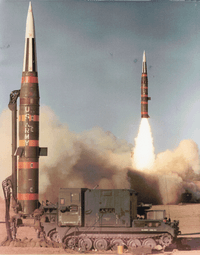
Pershing round 32 launched from Hueco Range, Texas by A Battery, 2nd Battalion, 44th Field Artillery, targeted for White Sands Missile Range on 20 August 1963
|
|
| Type | Surface-to-surface guided missile |
| Place of origin | United States |
| Service history | |
| In service | 1962–1969 |
| Used by |
|
| Production history | |
| Designer | The Martin Company |
| Designed | 1958–1960 |
| Manufacturer | The Martin Company Martin Marietta |
| Produced | 1960–1969 |
| No. built | 754 MGM-31A missiles |
| Specifications | |
| Mass | 10,275 pounds (4,661 kg) |
| Length | 34.6 feet (10.5 m) |
| Diameter | 40 inches (1 m) |
| Blast yield |
|
|
|
|
| Engine |
|
|
Operational
range |
460 miles (740 km) |
| Boost time | 77.3 seconds |
| Maximum speed | Mach 8 |
|
Guidance
system |
Eclipse-Pioneer ST-120 inertial guidance |
|
Steering
system |
Jet vanes, air vanes |
| Accuracy | 1,310 feet (400 m) circular error probable |
|
Launch
platform |
M474 transporter erector launcher |
How the Pershing 1 Was Made
In 1956, the Martin Company started building a missile factory in Orlando, Florida. This factory is still used today by Lockheed Martin.
The United States Army wanted a new missile with a range of about 500 to 750 nautical miles. At first, the U.S. Secretary of Defense limited the Army to missiles under 200 miles. But this rule was changed in 1958, allowing the Army to develop longer-range missiles.
The new missile was first called "Redstone-S" because it used solid fuel. It was later renamed "Pershing" to honor General John J. Pershing. Several companies offered ideas for the missile. The Martin Company was chosen to build the Pershing system.
The first test launch of the Pershing 1 missile happened on February 25, 1960. It was launched from a special vehicle called a transporter erector launcher (TEL) on July 26, 1960.
Where the Pershing 1 Was Used
Both President Dwight D. Eisenhower and President John F. Kennedy saw the Pershing missile during its early development.
The plan was to have ten missile battalions, but this was reduced to one battalion in the U.S. and three in West Germany. The first Pershing units were trained at Fort Sill.
The German Air Force also began training to use the Pershing. Each missile battalion was given more launchers over time. By 1965, three U.S. Army battalions and two German Air Force units were using the Pershing in Germany.
How the Pershing 1 Missile Worked
The Pershing 1 missile had two Thiokol solid-propellant motors. Solid-propellant motors cannot be turned off. So, the missile used special methods to control its range, like reversing thrust or venting fuel.
The missile was guided by an analog computer and an inertial navigation system. This system helped the missile know where it was going. The missile could carry a conventional explosive warhead, but it was never used. It mainly carried a W50 nuclear warhead with different power options. The maximum range of the missile was about 740 kilometers (460 miles).
Ground Equipment for Pershing 1
The Pershing 1 system used four tracked vehicles, much fewer than the older Redstone missile. These vehicles were called the "land train."
- The transporter erector launcher (TEL) carried the missile and lifted it into position for launch.
- The warhead carrier transported the warhead and other parts.
- The PTS/PS carrier carried the Programmer Test Station (PTS) and Power Station (PS). The PTS helped check the missile and control the launch. The PS provided power.
A special radio system, the AN/TRC-80 Radio Terminal Set, was used for communication between missile units and headquarters. These vehicles and equipment could also be transported by CH-47 Chinook helicopters.
Aiming the Missile
To aim the missile, soldiers used two theodolites (special telescopes for measuring angles) and a target card. The missile's guidance system was then aligned to the north using another theodolite. This helped program the correct direction into the missile's computer.
Satellite Launcher Idea
In 1961, there was an idea to use the Pershing missile to launch small satellites into space. This system was called Pegasus. It would have been able to put a 60-pound payload into orbit. However, this idea was never fully developed.
Gallery
- Pershing 1 land train
Pershing 1a
| Pershing 1a | |
|---|---|
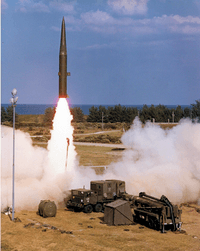
Pershing 1a launched from the Eastern Range, Cape Canaveral Air Force Station, Launch Complex 16 by C Battery, 3rd Battalion, 84th Field Artillery on 26 October 1976
|
|
| Type | Surface-to-surface guided missile |
| Place of origin | United States |
| Service history | |
| In service | 1969–1991 |
| Used by |
|
| Production history | |
| Designer | Martin Marietta |
| Designed | 1965–1969 |
| Manufacturer | Martin Marietta |
| Produced | 1969 |
| No. built | 754 MGM-31A missiles |
| Specifications | |
| Mass | 10,275 pounds (4,661 kg) |
| Length | 34.6 feet (10.5 m) |
| Diameter | 40 inches (1 m) |
| Blast yield |
|
|
|
|
| Engine |
|
|
Operational
range |
460 miles (740 km) |
| Boost time | 77.3 seconds |
| Maximum speed | Mach 8 |
|
Guidance
system |
Eclipse-Pioneer ST-120 inertial guidance |
|
Steering
system |
Jet vanes, air vanes |
| Accuracy | 1,310 feet (400 m) circular error probable |
|
Launch
platform |
M790 erector launcher |
| Transport | M757 5-ton tractor |
Improvements to Pershing
The Pershing 1a was an improved version of the Pershing 1. It was designed to be a "quick reaction alert" system. This meant it could be launched much faster. It had faster vehicles and newer electronic parts. The number of launchers per battalion also increased.
In 1971, the Pershing 1a got even more upgrades. The old analog computers in the missile were replaced with a single digital computer. This made the missile more reliable. More improvements in 1976 allowed a unit to fire three missiles very quickly from any location without needing to survey the area first.
Where the Pershing 1a Was Used
The Pershing 1a was used by three U.S. battalions and two German Air Force units in Europe. Each unit had 36 mobile launchers. West Germany was not allowed to own nuclear weapons. So, the U.S. Army kept control of the nuclear warheads.
The Pershing 1a was designed to be very mobile. This allowed it to move to hidden locations during times of alert or war. Its ability to move and hide made it one of the most survivable nuclear weapons in Europe.
During peacetime, some Pershing 1a units were always ready for a "quick reaction alert." They were on permanent sites, ready to hit assigned targets. Other units would train or be maintained. During times of increased tension, the units would move to secret field sites. They would then move to new firing positions often to make it harder for an enemy to find them.
Launchers and Support Equipment
The M790 erector launcher (EL) was a special trailer pulled by a truck. It could lift the 5-ton missile from flat to vertical in just nine seconds. The warhead was not attached during travel for safety. It was added using a special crane once the launcher was in place.
The Programmer Test Station (PTS) and Power Station (PS) were mounted on trucks. One PTS could control three launchers. This allowed all three missiles to be ready for launch quickly. A new system called the Automatic Reference System (ARS) made aiming the missile much faster. It used a special gyro and laser to quickly find north and orient the missile.
After a Pershing II accident in 1985, the German Air Force's Pershing 1a launchers were given ballistic shields for protection.
Gallery
Pershing II
The Pershing II was another two-stage ballistic missile built by Martin Marietta. It was made to replace the Pershing 1a system for the United States Army. The U.S. Army started using the Pershing II in 1983. The German Air Force kept using the Pershing 1a until all Pershing missiles were removed in 1991.
Who Used the Pershing Missile?
![]() United States: United States Army
United States: United States Army
- 56th Artillery Group (later Brigade)
- 1st Missile Battalion, 81st Artillery Regiment
- 3rd Missile Battalion, 84th Artillery Regiment
- 4th Missile Battalion, 41st Artillery Regiment
- 214th Artillery Group (later Brigade)
- 2nd Missile Battalion, 44th Artillery Regiment
- 1st Field Artillery Missile Brigade
- 2nd Missile Battalion, 79th Artillery Regiment
![]() West Germany: German Air Force
West Germany: German Air Force
- Missile Wing 1 (Flugkörpergeschwader 1)
- Missile Wing 2 (Flugkörpergeschwader 2)
End of the Pershing Missiles
The Pershing missile systems were removed from service after the Intermediate-Range Nuclear Forces Treaty was signed on May 27, 1988. This treaty aimed to reduce nuclear weapons.
The missiles started to be taken out of service in October 1988. The last of the missiles were destroyed in May 1991. Their motors were burned, and the missiles were crushed at the Longhorn Army Ammunition Plant in Texas. Even though the treaty didn't cover them, West Germany also agreed to remove its Pershing 1a missiles. They were destroyed in the United States.
See also
 In Spanish: MGM-31 Pershing para niños
In Spanish: MGM-31 Pershing para niños


